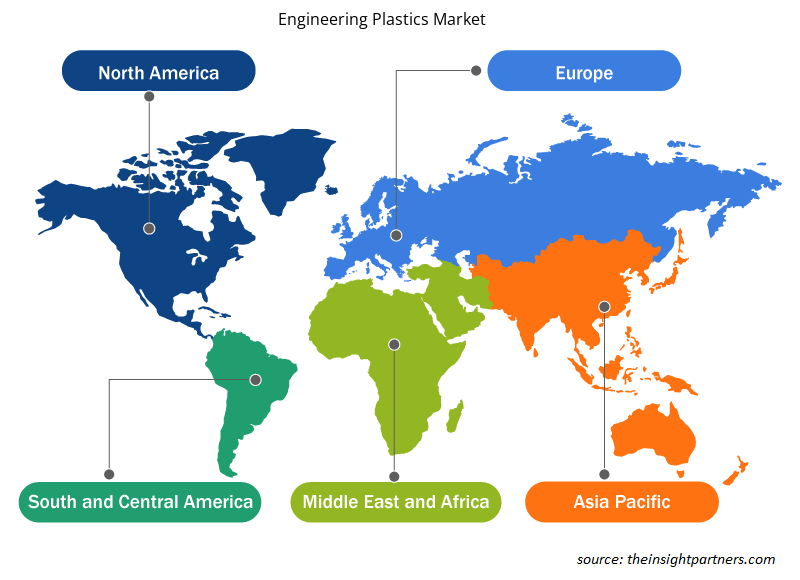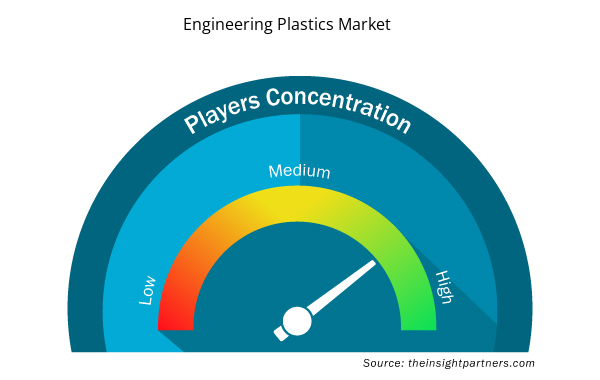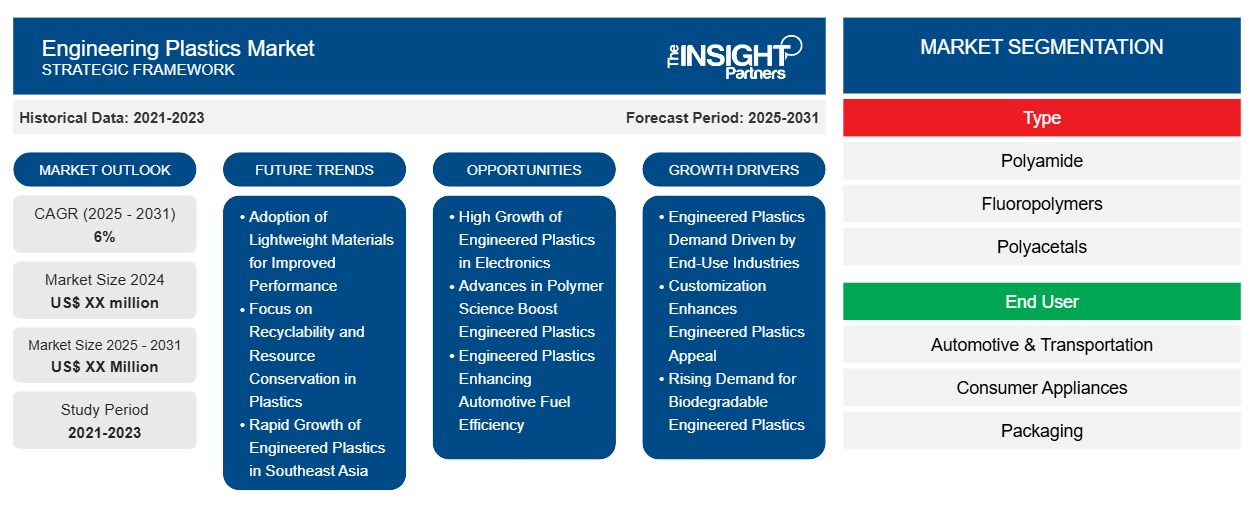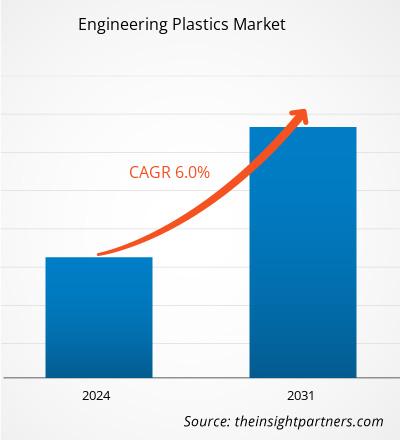Se espera que el mercado de plásticos de ingeniería registre una CAGR del 6% entre 2023 y 2031, con un tamaño de mercado que se expandirá de US$ XX millones en 2023 a US$ XX millones en 2031.
El mercado de plásticos de ingeniería cubre el análisis por tipo (poliamida, fluoropolímeros, poliacetales, poliésteres termoplásticos y policarbonatos), usuario final (automoción y transporte, electrodomésticos, embalaje, electricidad y electrónica, maquinaria industrial y otros) y geografía (América del Norte, Europa, Asia Pacífico, Oriente Medio y África, y América del Sur y Central). Los plásticos de ingeniería son un grupo de materiales plásticos que tienen mejores propiedades mecánicas y térmicas que los plásticos básicos. Los plásticos de ingeniería se utilizan en diversas aplicaciones que requieren un alto rendimiento con respecto a la estabilidad química y térmica, la resistencia al impacto, la estabilidad dimensional y la resistencia mecánica.
Propósito del Informe
El informe Engineering Plastics Market de The Insight Partners tiene como objetivo describir el panorama actual y el crecimiento futuro, los principales factores impulsores, los desafíos y las oportunidades. Esto proporcionará información a diversas partes interesadas del negocio, como:
- Proveedores/fabricantes de tecnología: Para comprender la dinámica cambiante del mercado y conocer las oportunidades potenciales de crecimiento, lo que les permitirá tomar decisiones estratégicas informadas.
- Inversionistas: Realizar un análisis exhaustivo de tendencias sobre la tasa de crecimiento del mercado, las proyecciones financieras del mercado y las oportunidades que existen en toda la cadena de valor.
- Órganos reguladores: Regular las políticas y vigilar las actividades del mercado con el objetivo de minimizar los abusos, preservar la confianza de los inversores y defender la integridad y estabilidad del mercado.
Segmentación del mercado de plásticos de ingeniería
Tipo
- Poliamida
- Fluoropolímeros
- Poliacetales
- Poliésteres termoplásticos
- Policarbonatos
Usuario final
- Automoción y transporte
- Electrodomésticos
- Embalaje
- Electricidad y electrónica
- Industrial y Maquinaria
Personalice este informe según sus necesidades
Obtendrá personalización en cualquier informe, sin cargo, incluidas partes de este informe o análisis a nivel de país, paquete de datos de Excel, así como también grandes ofertas y descuentos para empresas emergentes y universidades.
- Obtenga las principales tendencias clave del mercado de este informe.Esta muestra GRATUITA incluirá análisis de datos, desde tendencias del mercado hasta estimaciones y pronósticos.
Factores impulsores del crecimiento del mercado de plásticos de ingeniería
- Demanda de plásticos de ingeniería impulsada por las industrias de uso final: La principal fuerza impulsora de la demanda de plásticos de ingeniería es su amplia aplicación en diversos tipos de industrias de uso final, como la automotriz, la eléctrica y electrónica, la maquinaria industrial y los electrodomésticos. Sin embargo, los principales impulsores de la demanda están dominados por los fabricantes de equipos originales (OEM) de automóviles, que demandan constantemente materiales que puedan contribuir a mejorar la eficiencia del combustible y, al mismo tiempo, proporcionar la resistencia necesaria para un mayor rendimiento.
- La personalización mejora el atractivo de los plásticos de ingeniería: uno de los principales impulsores del crecimiento del mercado es la posibilidad de adaptar los plásticos de ingeniería a una variedad de aplicaciones. El fabricante puede modificar las propiedades peculiares de estos materiales de manera que cumplan con los requisitos muy diferentes de las industrias más variadas y, por lo tanto, mejoren significativamente su atractivo y funcionalidad.
- Demanda creciente de plásticos biodegradables diseñados: se espera que la demanda de bioplásticos (plásticos derivados de recursos renovables) aumente en una era en la que los consumidores y los fabricantes se centran en la sostenibilidad. La implementación de plásticos diseñados con la inclusión de material biodegradable atraerá a clientes conscientes del medio ambiente y estará en línea con los esfuerzos mundiales por construir una sociedad con un bajo nivel de residuos plásticos.
Tendencias futuras del mercado de plásticos de ingeniería
- Adopción de materiales ligeros para mejorar el rendimiento: en general, existe un creciente énfasis en el aligeramiento en todas las áreas de aplicación, como se resume anteriormente. Los materiales más ligeros y compuestos se utilizan principalmente en aplicaciones aeroespaciales y de vehículos. Los plásticos de ingeniería han proporcionado una alternativa generalmente positiva a materiales como los metales. Las reducciones de peso y la consiguiente eficiencia energética general se logran mediante el uso minimizado de estos materiales.
- Enfoque en la reciclabilidad y la conservación de recursos en los plásticos: como hoy en día la sostenibilidad es mucho más importante que nunca para los fabricantes (y, de hecho, también para los consumidores), se está prestando cada vez más atención a la reciclabilidad de los productos y a su respeto por el medio ambiente. En este contexto, los plásticos de ingeniería pueden considerarse una opción para la conservación de recursos, la reducción adecuada de los residuos plásticos y la promoción de prácticas de economía circular.
- Crecimiento rápido de los plásticos de ingeniería en el sudeste asiático: se observa un gran crecimiento de los plásticos de ingeniería en las economías emergentes, donde se puede observar una acumulación debido a la rápida industrialización y urbanización. La India, así como otros países del sudeste asiático, requerirían un enorme crecimiento de los plásticos, aunque la mayoría de los países muestran un crecimiento decente en estos sectores.
Oportunidades de mercado en el sector de los plásticos de ingeniería
- Alto crecimiento de los plásticos de ingeniería en la electrónica: el sector eléctrico y electrónico está creciendo a una tasa de crecimiento anual compuesta (CAGR) muy buena, proyectada en un 8,09 % en valor. El crecimiento se ve impulsado por la adopción continua de materiales avanzados y prácticas de fabricación inteligentes, lo que requiere plásticos de alto rendimiento que puedan funcionar a altas temperaturas y ofrecer aislamiento eléctrico.
- Los avances en la ciencia de los polímeros impulsan los plásticos de ingeniería: las innovaciones en la ciencia de los polímeros están dando lugar a propiedades mejoradas de los plásticos de ingeniería que los convierten en un material más versátil para una amplia gama de aplicaciones. Algunas mejoras incluyen resistencia y resistencia al calor, así como resistencia a los ataques químicos, necesarios para las técnicas de fabricación actuales.
- Plásticos de ingeniería que mejoran la eficiencia de combustible en los automóviles: cada vez se encuentran más áreas de superficie en las que se utilizan materiales livianos para mejorar la eficiencia de combustible y reducir las emisiones de los vehículos en la industria automotriz. Los plásticos de ingeniería se vuelven indispensables en las características de diseño de un vehículo y podrían incorporarse en componentes interiores como molduras interiores y paneles exteriores como revestimiento de la carrocería y piezas debajo del capó.
Perspectivas regionales del mercado de plásticos de ingeniería
Los analistas de Insight Partners explicaron en detalle las tendencias y los factores regionales que influyen en el mercado de plásticos de ingeniería durante el período de pronóstico. Esta sección también analiza los segmentos y la geografía del mercado de plásticos de ingeniería en América del Norte, Europa, Asia Pacífico, Oriente Medio y África, y América del Sur y Central.

- Obtenga datos regionales específicos para el mercado de plásticos de ingeniería
Alcance del informe sobre el mercado de plásticos de ingeniería
| Atributo del informe | Detalles |
|---|---|
| Tamaño del mercado en 2023 | XX millones de dólares estadounidenses |
| Tamaño del mercado en 2031 | US$ XX millones |
| CAGR global (2023 - 2031) | 6% |
| Datos históricos | 2021-2022 |
| Período de pronóstico | 2024-2031 |
| Segmentos cubiertos | Por tipo
|
| Regiones y países cubiertos | América del norte
|
| Líderes del mercado y perfiles de empresas clave |
|
Densidad de actores del mercado de plásticos de ingeniería: comprensión de su impacto en la dinámica empresarial
El mercado de plásticos de ingeniería está creciendo rápidamente, impulsado por la creciente demanda de los usuarios finales debido a factores como la evolución de las preferencias de los consumidores, los avances tecnológicos y una mayor conciencia de los beneficios del producto. A medida que aumenta la demanda, las empresas amplían sus ofertas, innovan para satisfacer las necesidades de los consumidores y aprovechan las tendencias emergentes, lo que impulsa aún más el crecimiento del mercado.
La densidad de actores del mercado se refiere a la distribución de las empresas o firmas que operan dentro de un mercado o industria en particular. Indica cuántos competidores (actores del mercado) están presentes en un espacio de mercado determinado en relación con su tamaño o valor total de mercado.
Las principales empresas que operan en el mercado de plásticos de ingeniería son:
- Covestro AG
- BASF SE
- Solvay
- Corporación Celanese
- LG Químico.
Descargo de responsabilidad : Las empresas enumeradas anteriormente no están clasificadas en ningún orden particular.

- Obtenga una descripción general de los principales actores clave del mercado de plásticos de ingeniería
Puntos de venta clave
- Cobertura integral: el informe cubre de manera integral el análisis de productos, servicios, tipos y usuarios finales del mercado de plásticos de ingeniería, proporcionando un panorama holístico.
- Análisis de expertos: el informe se compila sobre la base de un profundo conocimiento de expertos y analistas de la industria.
- Información actualizada: El informe asegura relevancia comercial debido a su cobertura de información reciente y tendencias de datos.
- Opciones de personalización: este informe se puede personalizar para satisfacer los requisitos específicos del cliente y adaptarse adecuadamente a las estrategias comerciales.
Por lo tanto, el informe de investigación sobre el mercado de plásticos de ingeniería puede ayudar a abrir camino para descifrar y comprender el escenario de la industria y las perspectivas de crecimiento. Si bien puede haber algunas preocupaciones válidas, los beneficios generales de este informe tienden a superar las desventajas.
- Análisis histórico (2 años), año base, pronóstico (7 años) con CAGR
- Análisis PEST y FODA
- Tamaño del mercado Valor/volumen: global, regional, nacional
- Industria y panorama competitivo
- Conjunto de datos de Excel



Report Coverage
Revenue forecast, Company Analysis, Industry landscape, Growth factors, and Trends

Segment Covered
This text is related
to segments covered.

Regional Scope
North America, Europe, Asia Pacific, Middle East & Africa, South & Central America

Country Scope
This text is related
to country scope.
Preguntas frecuentes
The increased focus on recycled products is an emerging trend in the market.
Based on geography, North America held the largest share of the engineering plastics market due to the the growing expansion in automotive industry in the region.
The automotive industry accounted for the largest market share in 2023.
Covestro AG, BASF SE, Solvay, Celanese Corporation, LG Chem, LANXESS, SABIC, DowDuPont, Mitsubishi Engineering-Plastics Corporation, and Evonik Industries AG are some of the key players in the market.
The principal driving force for demand in engineered plastics is their vast applications in various types of end-use industries.
The Engineering Plastics Market is estimated to witness a CAGR of 6% from 2023 to 2031
Trends and growth analysis reports related to Chemicals and Materials : READ MORE..
1. Covestro AG
2. BASF SE
3. Solvay
4. Celanese Corporation
5. LG Chem.
6. LANXESS
7. SABIC
8. DowDuPont
9. Mitsubishi Engineering-Plastics Corporation
10. Evonik Industries AG
The Insight Partners performs research in 4 major stages: Data Collection & Secondary Research, Primary Research, Data Analysis and Data Triangulation & Final Review.
- Data Collection and Secondary Research:
As a market research and consulting firm operating from a decade, we have published and advised several client across the globe. First step for any study will start with an assessment of currently available data and insights from existing reports. Further, historical and current market information is collected from Investor Presentations, Annual Reports, SEC Filings, etc., and other information related to company’s performance and market positioning are gathered from Paid Databases (Factiva, Hoovers, and Reuters) and various other publications available in public domain.
Several associations trade associates, technical forums, institutes, societies and organization are accessed to gain technical as well as market related insights through their publications such as research papers, blogs and press releases related to the studies are referred to get cues about the market. Further, white papers, journals, magazines, and other news articles published in last 3 years are scrutinized and analyzed to understand the current market trends.
- Primary Research:
The primarily interview analysis comprise of data obtained from industry participants interview and answers to survey questions gathered by in-house primary team.
For primary research, interviews are conducted with industry experts/CEOs/Marketing Managers/VPs/Subject Matter Experts from both demand and supply side to get a 360-degree view of the market. The primary team conducts several interviews based on the complexity of the markets to understand the various market trends and dynamics which makes research more credible and precise.
A typical research interview fulfils the following functions:
- Provides first-hand information on the market size, market trends, growth trends, competitive landscape, and outlook
- Validates and strengthens in-house secondary research findings
- Develops the analysis team’s expertise and market understanding
Primary research involves email interactions and telephone interviews for each market, category, segment, and sub-segment across geographies. The participants who typically take part in such a process include, but are not limited to:
- Industry participants: VPs, business development managers, market intelligence managers and national sales managers
- Outside experts: Valuation experts, research analysts and key opinion leaders specializing in the electronics and semiconductor industry.
Below is the breakup of our primary respondents by company, designation, and region:

Once we receive the confirmation from primary research sources or primary respondents, we finalize the base year market estimation and forecast the data as per the macroeconomic and microeconomic factors assessed during data collection.
- Data Analysis:
Once data is validated through both secondary as well as primary respondents, we finalize the market estimations by hypothesis formulation and factor analysis at regional and country level.
- Macro-Economic Factor Analysis:
We analyse macroeconomic indicators such the gross domestic product (GDP), increase in the demand for goods and services across industries, technological advancement, regional economic growth, governmental policies, the influence of COVID-19, PEST analysis, and other aspects. This analysis aids in setting benchmarks for various nations/regions and approximating market splits. Additionally, the general trend of the aforementioned components aid in determining the market's development possibilities.
- Country Level Data:
Various factors that are especially aligned to the country are taken into account to determine the market size for a certain area and country, including the presence of vendors, such as headquarters and offices, the country's GDP, demand patterns, and industry growth. To comprehend the market dynamics for the nation, a number of growth variables, inhibitors, application areas, and current market trends are researched. The aforementioned elements aid in determining the country's overall market's growth potential.
- Company Profile:
The “Table of Contents” is formulated by listing and analyzing more than 25 - 30 companies operating in the market ecosystem across geographies. However, we profile only 10 companies as a standard practice in our syndicate reports. These 10 companies comprise leading, emerging, and regional players. Nonetheless, our analysis is not restricted to the 10 listed companies, we also analyze other companies present in the market to develop a holistic view and understand the prevailing trends. The “Company Profiles” section in the report covers key facts, business description, products & services, financial information, SWOT analysis, and key developments. The financial information presented is extracted from the annual reports and official documents of the publicly listed companies. Upon collecting the information for the sections of respective companies, we verify them via various primary sources and then compile the data in respective company profiles. The company level information helps us in deriving the base number as well as in forecasting the market size.
- Developing Base Number:
Aggregation of sales statistics (2020-2022) and macro-economic factor, and other secondary and primary research insights are utilized to arrive at base number and related market shares for 2022. The data gaps are identified in this step and relevant market data is analyzed, collected from paid primary interviews or databases. On finalizing the base year market size, forecasts are developed on the basis of macro-economic, industry and market growth factors and company level analysis.
- Data Triangulation and Final Review:
The market findings and base year market size calculations are validated from supply as well as demand side. Demand side validations are based on macro-economic factor analysis and benchmarks for respective regions and countries. In case of supply side validations, revenues of major companies are estimated (in case not available) based on industry benchmark, approximate number of employees, product portfolio, and primary interviews revenues are gathered. Further revenue from target product/service segment is assessed to avoid overshooting of market statistics. In case of heavy deviations between supply and demand side values, all thes steps are repeated to achieve synchronization.
We follow an iterative model, wherein we share our research findings with Subject Matter Experts (SME’s) and Key Opinion Leaders (KOLs) until consensus view of the market is not formulated – this model negates any drastic deviation in the opinions of experts. Only validated and universally acceptable research findings are quoted in our reports.
We have important check points that we use to validate our research findings – which we call – data triangulation, where we validate the information, we generate from secondary sources with primary interviews and then we re-validate with our internal data bases and Subject matter experts. This comprehensive model enables us to deliver high quality, reliable data in shortest possible time.


 Obtenga una muestra gratuita de este informe
Obtenga una muestra gratuita de este informe